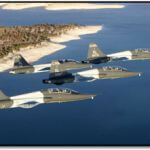

Originally called Laughlin Field, Laughlin Air Force base has been training pilots on a variety of airframes since 1942.
In 1942, the Army Air Corps opened Laughlin Field as a training base for the Martin B-26, but it was deactivated in 1945. Later as Cold War pressures built, Laughlin Field was rebuilt and renamed Laughlin Air Force Base. It was again used as a home for flying training. In the mid-1950s, the Strategic Air Command noted Laughlin's remoteness that allowed for secret operations, and opened its strategic reconnaissance program there.
Strategic Air Command initially stationed the RB-57—a long-winged version of the new jet bomber, the B-57—at Laughlin AFB on April 1st, 1957, and shortly thereafter introduced the highly classified U-2 to Laughlin as well. These planes flew high-altitude reconnaissance missions over countries behind the Iron Curtain. The 4080th Strategic Reconnaissance Wing, which operated the U-2, was credited with obtaining the first pictures of the Soviet missile build-up in Cuba during October 1962, which triggered the "Cuban Missile Crisis." The only casualty of the crisis was Laughlin's Major Rudolph Anderson, whose U-2 was shot down over Cuba. In 1962, Strategic Air Command transferred control of the base back to the Air Training Command, and the following year the 4080th moved its strategic reconnaissance program to Davis-Monthan Air Force base near Tucson, Arizona. Since then, Laughlin has housed the Air Education and Training Command Undergraduate Pilot Training program. Now one of five USAF pilot training facilities, Laughlin has trained over 15,000 U.S. Air Force pilots as of 2019.
